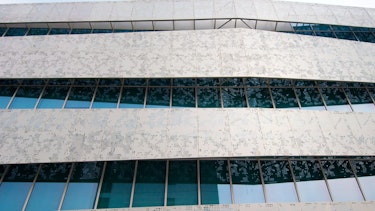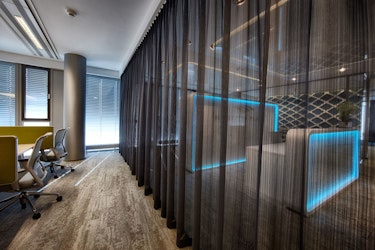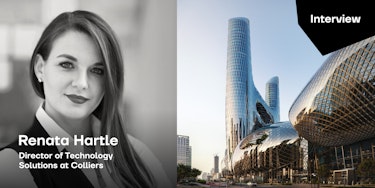Renata is presently Director of Technology Solutions at Colliers. Renata is dedicated to advancing digitization in Real Estate. Her role involves assisting in shaping Smart Building Strategies, overseeing the incorporation and coordination of smart solutions in buildings, and educating end-users for optimal engagement. She collaborates extensively with both startups and major tech companies to create technological solutions that align with the genuine requirements of building occupants, leaders, and owners.
Full interview:
Alina: Hello, Renata. Thank you for joining us. Today we want to dive more into your work and a little bit in your life. As the first question at the start, I know that you have more than eight years’ experience in the real estate industry. Let's begin, if you don't mind, from generally your path, starting from your time at Skanska and until now Colliers International.
Renata: In 2011, I joined Skanska as a young HR Business Partner, tasked with talent recruitment and development. I organized training sessions, designed career paths, recruited engineers, and learned about technical project aspects. Recognizing the importance of fostering creativity and innovation, I initiated "creativity mingle" sessions, encouraging innovative thinking through exercises that generated great ideas. However, many of these ideas remained unrealized. To address this, I continued working on this initiative alongside my HR role. Our company formed a team to develop a new five-year strategy, with innovation as a key component. I collaborated with colleagues from various countries on implementing this strategy and pushing innovative ideas forward. Eventually, I was nominated to become the Innovation Manager, responsible for bringing these ideas to life. This marked the beginning of my journey into real estate innovation and technology. As an Innovation Manager at Skanska, my role was to create a program connecting technologies for more innovative buildings. This included defining the program, working with a software team to develop a system, and implementing solutions across different projects and locations. I learned a lot and made mistakes as we were pioneering in our region. After that, I joined Colliers to help landlords and developers address technology aspects in buildings, define smart building strategies, and ensure technology adoption by training occupiers and users.

Credit: Eurobuild CEE
Alina: Let's talk about your projects a bit more. I'm curious about projects like Skanska, Colliers Mobility Pass, and Whirla Smart Office. Could you tell me more about these projects and when the idea for it came about?
Renata: I got involved in these projects gradually. Even when I was working with Skanska in the United States, I came across a startup called Upflex, which provided access to multiple co-working spaces. I was so intrigued by their concept that I even thought about quitting my job to start something similar in Europe. However, I realized it didn't make sense since Upflex was already advanced. So, when I moved to Colliers, I focused on how to establish a partnership with them and introduce their service in Poland. Fortunately, two months later, Colliers in the United States signed a partnership agreement with Upflex, allowing me to build a network in Poland for co-working spaces to join Upflex. Regarding Whirla, they initiated a project in Warsaw involving induction charging for desks. The idea was to indicate desk availability by charging phones. However, this concept had limitations as people often used their phones while working, not everyone had induction charging, and it wasn't clear why we needed to know desk availability. But we began working together, and they switched to using sensors to detect if someone was sitting at a desk. A few years later, I suggested adding QR codes as a more cost-effective solution. When I joined Colliers, we established a partnership and worked on enhancing the product. They had persistently approached me for three years, constantly proposing new ideas to improve it. I became deeply invested in the project, and now it has grown to the point where major corporations are using it, especially with the changes brought by Covid, where desk and parking booking systems became essential. I'm incredibly proud of how the journey has unfolded and where we are today.

Credit: Colliers
Alina: I'm aware that you've had experience working with both tech giants and startups. Can you share the differences you've observed when working in a large corporation versus a smaller company?
Renata: During my time with Skanska in the United States, I experienced the dynamic of working, which was quite energizing. It reinforced my belief in what's possible and encouraged innovation. Working in a large corporation with established structures and processes can sometimes discourage innovation. In a smaller team, there's a more direct connection with people who have ideas and thoughts, and it creates a mutually beneficial situation. The small team relies on your perspective, and it's a win-win scenario when there's transparency and mutual support.
However, there are cultural differences between the CEE region and the United States. The U.S. has a more traditional business culture with defined etiquette, dress codes, and hierarchical norms, whereas the CEE region tends to be more easygoing, driven by a younger generation with fresh ideas. We're eager to adopt new solutions and catch up with more established markets. For example, in terms of technology adoption, I observed that the CEE region, including countries like France, Germany, and the UK, embraced solutions more rapidly than the United States. Contactless payments and fintech, for instance, saw quicker adoption here, with people readily transitioning to mobile payments when offered, while the infrastructure in the U.S. was slower to adapt.
Alina: Can you share other distinctions you've noticed when working in various markets such as CEE, Nordic, and the United States? Are there any additional differences you've encountered beyond what we've discussed?
Renata: Ultimately, the difference often comes down to the mindset of the customer or partner you're working with. However, in general, I've found that the CEE region tends to make decisions faster and move more swiftly. There's also a greater tolerance for making mistakes here compared to the West. While a meticulous approach makes sense, it can sometimes lead to missed opportunities. Speed and flexibility are key, as demonstrated by the lessons from Covid.
When implementing technology in buildings, I always emphasize the importance of embedding flexibility. For instance, when we worked on the QR code entry idea with Skanska, we ensured that occupiers could turn it on or off as needed. We considered flexibility at every level of software setup, allowing users to customize settings at the individual, group, or company level. Covid taught us that companies can change their preferences even after signing long leases. Future-proofing involves adapting to change and not imposing ideas on everyone.

Credit: Colliers
Alina: What are your thoughts on the current trends in the real estate sector?
Renata: AI is unquestionably significant. I believe that for anyone involved in the tech industry, AI represents a fundamental shift.
Alina: You also noticed that within a moment, the market saw the emergence of over a thousand AI tools, programs, including ChatGPT. What, in your opinion, were the factors behind this remarkably rapid surge in AI tool development?
Renata: Several factors converged to drive the rapid growth of AI tools. One comparison I often make is to the sharing economy. In 2008, companies like WeWork, Airbnb, and Uber emerged. This wasn't a coincidence. It was the year when millennials entered the workforce, a global crisis hit, and iPhones with app ecosystems became prevalent. People across different regions observed these trends and began thinking similarly: Why own something when you can share it? Why have a dedicated office when you can share it with others? Technology served as the foundation for making these ideas a reality. From a technological perspective, the increasing power of quantum computers, in line with Moore's Law, played a role. OpenAI initially started as a foundation with a focus on using artificial intelligence to benefit humanity. Over time, they commercialized their efforts, and models like ChatGPT emerged. Such models can be applied in various ways, similar to how Google Maps transformed multiple industries, from Uber to delivery services. The crucial aspect is that you don't have to build everything from scratch; you can leverage existing technologies, which significantly speeds up innovation. OpenAI's strategy of openness and allowing people to test their models attracted early adopters who demonstrated the potential applications, essentially becoming educators on how to prompt AI effectively. The future of AI holds incredible potential, and it's challenging to fully grasp the new possibilities that will continue to emerge in the coming years.
Alina: Do you think it's going to replace some of the businesses or is just going to be a tool in the hands of humans?
Renata: AI innovation brings about a combination of effects. It eliminates unnecessary tasks while introducing new possibilities. Personally, I find myself creating approximately 12 PowerPoint presentations a week, and while AI can help speed up this process, the expectation is that it should be completed in a matter of minutes, giving us more time for other tasks.There are certain areas where AI can be particularly useful, such as automating routine and repetitive tasks. For instance, manual data entry from invoices has largely been replaced by automated scanning and pre-booking of invoices received via email.
However, when it comes to tasks like rendering, AI proves to be a valuable tool. Different prompts can yield various outcomes, and the challenge often lies in fine-tuning the results to meet specific preferences. AI is a tool that complements professionals, enabling them to work more efficiently. It allows for the creation of multiple renders in minutes, which can steer conversations with customers in different directions. Clients can provide feedback on what they like or dislike, leading to more tailored results.
I personally like BlogNLP, which helps in writing and creating content. So, you, for example, say like, I want to speak about this and it gives you ten ideas on how you can name this topic, depending if it's for LinkedIn or if it's for live presentation.

Credit: Colliers
Alina: In addition to artificial intelligence, which we've covered extensively, what do you foresee as the next significant step in the evolution of the real estate sector? Are there any other game changers on the horizon that you believe will be pivotal for the industry's future?
Renata: I believe that one crucial development that needs to occur is the standardization of data sharing and usage in the real estate sector. While we've made progress in connecting systems through APIs in recent years, there's still a lack of uniformity in how data is collected and shared. To truly advance toward smart cities and a globally interconnected world, we must establish common data standards.
In the future, we should aim to share resources more efficiently, such as parking spaces between residential and office areas, reducing the need for additional parking structures. Additionally, we should have the ability to benchmark our buildings' energy efficiency against others, even in a competitive sense. Knowing how our buildings compare to neighbors can drive us to improve collectively for the betterment of our planet. It's about fostering a sense of shared responsibility and a commitment to sustainability.
Alina: Perfect. I think that's an excellent note to end on. Thank you so much for joining us today, Renata. I understand you have a busy schedule, and I appreciate your time.
